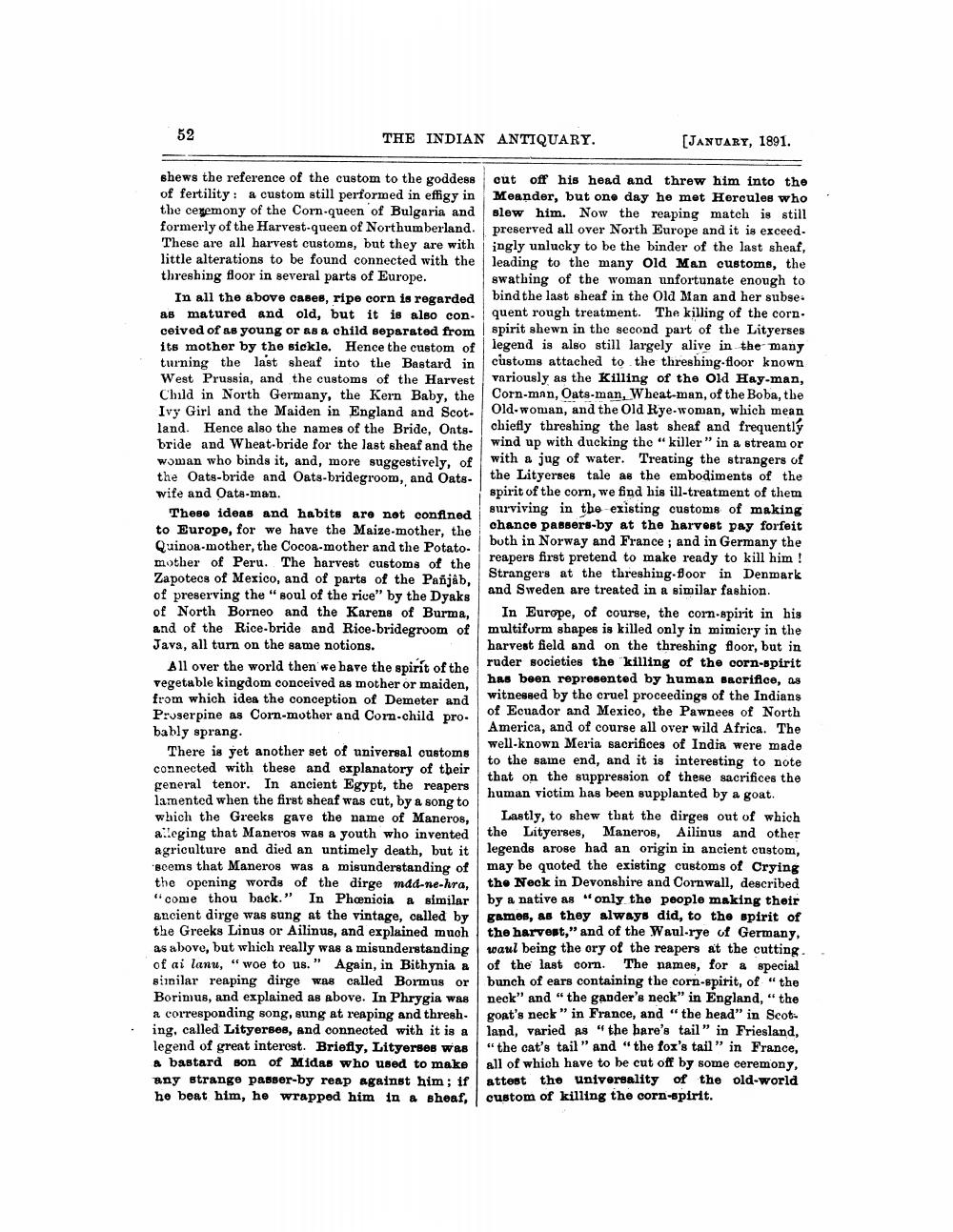________________
52
THE INDIAN ANTIQUARY.
shews the reference of the custom to the goddess of fertility: a custom still performed in effigy in the ceremony of the Corn-queen of Bulgaria and formerly of the Harvest-queen of Northumberland. These are all harvest customs, but they are with little alterations to be found connected with the threshing floor in several parts of Europe.
In all the above cases, ripe corn is regarded as matured and old, but it is also con. ceived of as young or as a child separated from its mother by the sickle. Hence the custom of turning the last sheaf into the Bastard in West Prussia, and the customs of the Harvest Child in North Germany, the Kern Baby, the Ivy Girl and the Maiden in England and Scotland. Hence also the names of the Bride, Ontsbride and Wheat-bride for the last sheaf and the woman who binds it, and, more suggestively, of the Oats-bride and Oats-bridegroom,, and Oatswife and Oats-man.
These ideas and habits are not confined to Europe, for we have the Maize-mother, the Quinoa-mother, the Cocoa-mother and the Potatomother of Peru. The harvest customs of the Zapotecs of Mexico, and of parts of the Pañjab, of preserving the "soul of the rice" by the Dyaks of North Borneo and the Karens of Burma, and of the Rice-bride and Rice-bridegroom of Java, all turn on the same notions.
All over the world then we have the spirit of the vegetable kingdom conceived as mother or maiden, from which idea the conception of Demeter and Proserpine as Corn-mother and Corn-child pro. bably sprang.
There is yet another set of universal customs connected with these and explanatory of their general tenor. In ancient Egypt, the reapers lamented when the first sheaf was cut, by a song to which the Greeks gave the name of Maneros, alleging that Maneros was a youth who invented agriculture and died an untimely death, but it scems that Maneros was a misunderstanding of the opening words of the dirge mad-ne-hra, "come thou back." In Phoenicia a similar ancient dirge was sung at the vintage, called by the Greeks Linus or Ailinus, and explained much as above, but which really was a misunderstanding of ai lanu, "woe to us." Again, in Bithynia a similar reaping dirge was called Bormus or Borimus, and explained as above. In Phrygia was a corresponding song, sung at reaping and thresh ing, called Lityerses, and connected with it is a legend of great interest. Briefly, Lityerses was a bastard son of Midas who used to make any strange passer-by reap against him; if he beat him, he wrapped him in a sheaf,
[JANUARY, 1891.
cut off his head and threw him into the Meander, but one day he met Hercules who slew him. Now the reaping match is still preserved all over North Europe and it is exceed. ingly unlucky to be the binder of the last sheaf, leading to the many Old Man customs, the swathing of the woman unfortunate enough to bind the last sheaf in the Old Man and her subse. quent rough treatment. The killing of the cornspirit shewn in the second part of the Lityerses legend is also still largely alive in the many customs attached to the threshing-floor known variously as the Killing of the Old Hay-man, Corn-man, Oats-man, Wheat-man, of the Boba, the Old-woman, and the Old Rye-woman, which mean chiefly threshing the last sheaf and frequently wind up with ducking the "killer" in a stream or with a jug of water. Treating the strangers of the Lityerses tale as the embodiments of the spirit of the corn, we find his ill-treatment of them surviving in the existing customs of making chance passers-by at the harvest pay forfeit both in Norway and France; and in Germany the reapers first pretend to make ready to kill him! Strangers at the threshing-foor in Denmark and Sweden are treated in a similar fashion.
In Europe, of course, the corn-spirit in his multiform shapes is killed only in mimicry in the harvest field and on the threshing floor, but in ruder societies the killing of the corn-spirit has been represented by human sacrifice, as witnessed by the cruel proceedings of the Indians of Ecuador and Mexico, the Pawnees of North
America, and of course all over wild Africa. The well-known Meria sacrifices of India were made that on the suppression of these sacrifices the to the same end, and it is interesting to note human victim has been supplanted by a goat.
Lastly, to shew that the dirges out of which the Lityerses, Maneros, Ailinus and other legends arose had an origin in ancient custom, may be quoted the existing customs of Crying the Neck in Devonshire and Cornwall, described by a native as "only the people making their games, as they always did, to the spirit of the harvest," and of the Waul-rye of Germany, waul being the ory of the reapers at the cutting. of the last corn. The names, for a special bunch of ears containing the corn-spirit, of "the neck" and "the gander's neck" in England, "the goat's neck" in France, and "the head" in Scotland, varied as "the hare's tail" in Friesland, "the cat's tail" and "the fox's tail" in France, all of which have to be cut off by some ceremony, attest the universality of the old-world custom of killing the corn-spirit.




